Snake Longer Than School Bus Discovered!
Posted by: Loren Coleman on February 4th, 2009
The colossal newly discovered snake Titanoboa cerrejonensis, from Colombia. Jason Bourque, University of Florida/Handout
“Indiana Jones take heart: A snake on the loose 58 million years ago would help everyone understand your phobia,” exclaimed Janice Lloyd at USA Today.
“It was the all-time titan of snakes — a monster as long as a Tyrannosaurus rex that stalked a steamy South American rain forest after the demise of the dinosaurs and ate crocodiles for breakfast, lunch and dinner,” noted Will Dunham of the News Daily.
“Any character in a B-list film would yelp ‘Snake? Snaaaake!’ upon spotting a specimen stretching longer than a school bus – and now scientists have uncovered the remains of such a beast,” wrote Jeremy Hsu at PopSci.
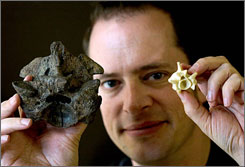
Jason Head of the University of Toronto holds up a giant vertebra of Titanoboa, left, and the vertebra of a 17-ft long modern green anaconda. Photo by Diane Scott, USA TODAY
“It is a mind-bogglingly big snake. This thing is a crocodile eater, catching and eating them in the water. It was a bad day for the crocs,” paleontologist Jason Head of the University of Toronto Mississauga said in a media interview.
Paleontologist Jonathan Bloch of the University of Florida’s Florida Museum of Natural History said, “When people think of Tyrannosaurus rex and how huge that thing was, this really is in the order of magnitude of Tyrannosaurus rex, in terms of length and in terms of caliber of gigantic.”
“At its greatest width, the snake would have come up to about your hips. The size is pretty amazing,” said co-author P. David Polly, from Indiana University at Bloomington. “Probably like an anaconda, it spent a lot of time in the water.”
The headlines and exciting remarks will be forthcoming for the next 48 hours, no doubt. A giant fossil snake has been discovered.
An international team of scientists on February 4th announced the discovery in northern Colombia of fossil remains of the largest snake ever known to have lived. It is named Titanoboa cerrejonensis, meaning titanic boa from Cerrejon, the open-pit coal mine where its fossils were found.
Titanoboa was at least 43 feet long, weighed 2,500 pounds (1,140 kg) and its massive body was at least 3 feet (1 meter) wide, they wrote in the journal Nature.
It was the largest inhabitant of a hot, lush tropical rain forest and probably hunted forms of crocodiles, large fish and big fresh water turtles. It was not venomous and likely lived a lifestyle akin to the large river-dwelling anacondas of today, wrapping around its unfortunate prey.
Titanoboa lived 58 million to 60 million years ago, when Earth’s animal kingdom was still recovering from the mass extinction that doomed the dinosaurs and many other creatures 65 million years ago when an asteroid hit near the Yucatan coast of Mexico. It may have been the largest non-ocean vertebrate then on Earth.
Its ecosystem was similar to today’s Amazon rain forest but hotter. The researchers estimated a snake of its size would have needed an average annual temperature in equatorial South America of 86 to 93 degrees Fahrenheit (30 to 34 degrees Celsius) to survive.
Of modern snakes, Titanoboa is most closely related to boa constrictors, except that it was the length of a school bus.
The scientists recovered fossil vertebrae and ribs, but no skull or teeth, from 28 different individuals. They think the largest Titanoboa may have been 49 feet or longer.
Previously, the largest known snake was Gigantophis (above and below), which lived about 39 million years ago in Egypt and was at least 33 feet long. The longest of today’s snakes is the reticulated python, measuring perhaps 30 feet.
Of course, for cryptozoology, this places before us a new candidate for reports already overflowing from our files! South America may be revealing its secrets, after all.
Sources (all Feb. 4th): “Titanic ancient snake was as long as Tyrannosaurus,” by Will Dunham, News Daily; “Fossilized remains of mammoth snake discovered,” by Janice Lloyd, USA Today; “Largest Snake on Earth Uncovered,” by Jeremy Hsu, PopSci. Also, see chapter on “Giant Snakes” in Mysterious America; references to giant cryptid snakes in Cryptozoology A to Z: The Encyclopedia of Loch Monsters, Sasquatch, Chupacabras, and Other Authentic Mysteries of Nature.
Thanks to Bob Matawan, Anthony T. Hartman and Richard Hendricks, for their alerts to this news.
About Loren Coleman
Loren Coleman is one of the world’s leading cryptozoologists, some say “the” leading living cryptozoologist. Certainly, he is acknowledged as the current living American researcher and writer who has most popularized cryptozoology in the late 20th and early 21st centuries.
Starting his fieldwork and investigations in 1960, after traveling and trekking extensively in pursuit of cryptozoological mysteries, Coleman began writing to share his experiences in 1969. An honorary member of Ivan T. Sanderson’s Society for the Investigation of the Unexplained in the 1970s, Coleman has been bestowed with similar honorary memberships of the North Idaho College Cryptozoology Club in 1983, and in subsequent years, that of the British Columbia Scientific Cryptozoology Club, CryptoSafari International, and other international organizations. He was also a Life Member and Benefactor of the International Society of Cryptozoology (now-defunct).
Loren Coleman’s daily blog, as a member of the Cryptomundo Team, served as an ongoing avenue of communication for the ever-growing body of cryptozoo news from 2005 through 2013. He returned as an infrequent contributor beginning Halloween week of 2015.
Coleman is the founder in 2003, and current director of the International Cryptozoology Museum in Portland, Maine.

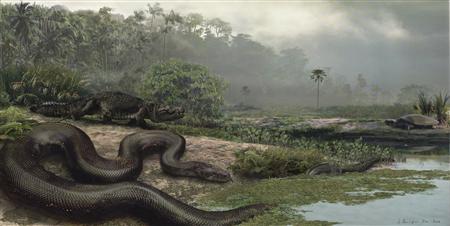
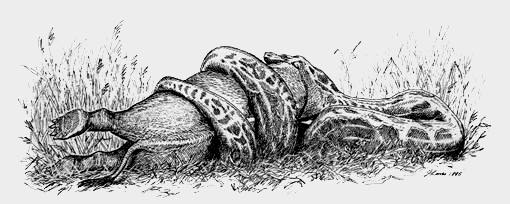
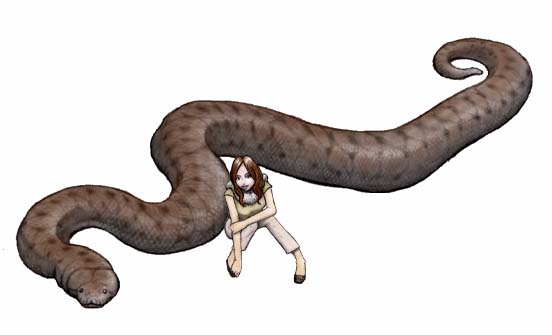
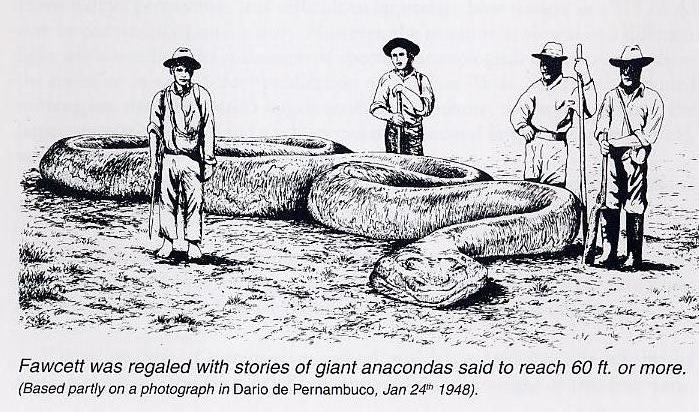









Thanks Loren, that is a very interesting story, right up my alley too, me being a snake lover/owner. My children are also very interested in snakes, my youngest having just brought home yesterday a book about cobras from his school’s library and wanted to share the read with me. So he’ll be delighted to read this when I get home from work this evening.
This report really makes one wonder about the possibility of some leftovers, considering the Megasnake reports speaking of snakes that dwarf even large anacondas.
Nice coincidence too that Megaconda was the subject of Animal Planet’s “Lost Tapes” episode last night.
Great find. I love seeing this discovery. Of all the stories and myths of giant snakes this story helps to give them some credibility. The only question is that is there perhaps a distant relative of this boa that is the basis of so many of the stories still heard today? I couldn’t help but think of the monster quest episode about giant snakes when reading this.
AWESOME
I’m not much of a snake lover, but this is a tremendous find. Great story! I can’t imagine what Indy would say if he saw such a snake. 🙂
Wonder why know heads or teeth were found? Too bad.
Long day, I meant to ponder in my previous message: Wonder why “no” heads or teeth were found?
This is very interesting news. While there has always been speculation that very large specimens of extant snake could be causing giant snake sightings, there had been no real physical evidence that any of even the largest snakes got nearly as big as is described in some reports. This new finding really adds some new and interesting possibilities.
This is the kind of hard, solid evidence that is needed in cryptozoology to bolster credibility of certain cryptid reports, and it is good to see it found in this case. I mean, imagine if a good fossil was found in North America, even a very old one, that matched up pretty much with what is seen in sasquatch reports. I am sure that would turn heads. Such a find would be invaluable to bolstering the plausibility of these hominids in North America.
Of course, this snake fossil is in no way is evidence that these mega snakes still exist, it wouldn’t be very scientific to jump the gun like that, but it adds good deal more plausibility to the claims of eyewitness reports. We now have the physical evidence of a real animal with which to compare, a biological precedent to support the stories of gigantic snakes.
“planettom responds: February 4th, 2009 at 6:02 pm
Long day, I meant to ponder in my previous message: Wonder why “no” heads or teeth were found? ”
Probably because the head has a lot of small bones and connective tissue, all designed to allow the snake to swallow prey much bigger than its head. Scavengers or predatory animals that eat snakes always start with the heads. Between decomposition and scavenging the head would be the first thing to become disarticulated and then scattered or altogether consumed. The vertebrae are much sturdier and thus hold up longer to go through the fossilization process.
Astonishing news!!!
This deserves further attention.
-T
Megaconda, a most bizzare and gorgeous animal. I think I’d like any animal with mega in it…giant anaconda…must be what people saw megaconda or something else.
Funny right now a MQ rerun is on and guess which one it is?
This is pretty exciting stuff and indeed it makes one wonder what other fossils will be found in the future. Plus the jungles of South America has tales of giant ground sloths I believe suriving in its forest. It makes you wonder what all is hiding there
It definitely makes you wonder…
Also, how fast would an animal that size would be? How often would it have to eat?
I’m glad to see you made the Fawcett connection! I did the same, when this story came down the wire.
What are the chances that these specimens, miraculously preserved (and found!) from approximately 5 million years AFTER the extinction event at the end of the Cretaceous are the largest of their species? I wonder what the physiologic limits are for snakes?
As for any living until today. I suppose it’s not likely considering the changes that have occured in the last 50 million years, but then again…if one was this large in the Amazonian basin or some other tropical jungle, mangrove forest or wet savannah somewhere, it would have been a pretty easy target if it were discovered for early humans interested in protecting their way of life.
Never the less, it’s nice to dream..or have nightmares, as the case may be.
Thank you Alligator, that makes perfect sense. Great explanation. I am not familiar with snake anatomy or bone structure.
I also would like to add my two cents about this exciting discovery. Although I do wish it wasn’t a fossil that was found—but a living specimen!!! That would have been incredible!!!
I am surprised no one is making a correlation between the giant snake discovery and the famous “Giant snake in the Congo” 1959 photograph taken by Belgian chopper pilot called Remy Van Lierde. Maybe he was telling the truth and his photo as far as I know was never discredited. Who can really prove the snake is extinct?
@WIDOW I’d not heard about the Van Lierde photo before, but a quick google reveals the story and the photo.
If it’s the size Van Lierde was reporting, there’s a good chance it’s related to Titanoboa.
(Oh, and if nobody’s seen it yet: Equally Large Boa! is very funny.)
You are welcome planettom.
“red_pill_junkie responds: February 5th, 2009 at 2:38 am
It definitely makes you wonder…
Also, how fast would an animal that size would be? How often would it have to eat?”
When pythons and boas take really LARGE prey , they are good for nearly a year. Ball pythons in Africa have gone as long as 22 months without eating. (That is assuming they were healthy and had good body weight before their “fast”) Today there are crocodiles in South America in the 20 ft range. In the late Cretaceous to early Pleistocene there were some species in the 30 – 40 foot range. A snake like this could scarf one down and be good for a full year or longer.
A whole year without eating! Wow! Thanks for the response, Alligator 🙂
drjon- The giant snake photo that Remy Van Lierde took always intrigued me as a kid. It is great to see these giant snake fossils found because it does give hope that that photo from 1959 was real. Many many hours I spent as a kid checking out Crypto books from my school library as well as the public library. Not much has changed!
there is something (or was 40 years ago) in the major water ways of the Amazon forests that is big enough to swallow a human whole, but doesn’t like us once we are down. I heard about this from a missionary to the natives down there. He was wondering why they always walked around a particular area of the river (he said the area was a better walk than the route they were taking). The answer was always sounding mysterious and one word (sorry, I was quite young when he said it–I don’t remember). Then he saw the reason up close, not the animal, but what it does. They found a full grown man (at least 5 feet or more) lying on the sand at the edge of the river covered in slime. He was dead. According to the chief this person had been eaten by this creature. Something about our body’s chemistry makes this creature ill, so it regurgitates the person. How big does a snake have to be to swallow a grown man whole?
“I wonder what the physiologic limits are for snakes?”
I’d imagine Titanoboa either is that limit, or damn close to it (like the azdharchid pterosaurs for flying animals).
Well, now that we have proof that a snake can grow that large…even a prehistoric cousin, that opens the door…
The real point of this find is that there are still plenty of creatures out there that we know nothing about…we keep discovering new animals and new fossils every day. That’s why being open minded about reports of giant snakes, Nessie, BF and so on is important. Nobody here on Cryptomundo is saying they have all the answers, but the fact is, there is still plenty of room in the world to hide critters, especially big ones!
Woo-hoo…Titanboa is cooooool!
I’ve heard of a giant snakelike creature moving up from S. America and into N.America.
Cool story!!! 🙂 times alot.
glad its finally been proven.one less mystery in this screwed-up world where the government hides stuff from the public.
Looks as if the “Naysayers” have been debunked…
The issue was never the length to width ratio, as there exist numerous land snakes with much longer length to width ratios than most of the large tropical constrictors,
but the cross-sectional mass effect on the skeletal, musculature and organ structure, particularly problematic for the skeptics of a land crawling snake upon its exit from the water.
The reports of 40 to 130 foot snakes from horse eating black boas, outsize anaconda subspecies to giant mottled amazonian snakes generally show a length to width ratio exceeding catalouged species (Dinsdales – The Leviathans; Col. Fawcett’s 62 foot “Ananconda” only 12″ in diameter).
Nearly all of the certain snake descriptions never exceed 30″ or 36″ in maximum diameter, even for reports exceeding 100′ in length with most reports being of aquatic shore line ambushers per crocodilian behaviour.
This fossil discovery of up to 1 meter (40″) in diameter and 50′ lengths elevates the contemporary reports to a greater level of veracity.